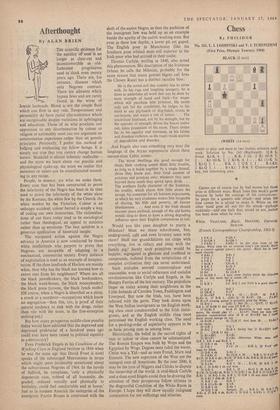Chess
By PHILIDOR
No. 161. L I. LOSHINSKI and V. I. TCHEPIZHNI (First Prize, Olympic Tourney, 1960)
BLACK (8 men) (WHITE (14 men)
WHITE to play and mate in two moves; solution next week. Solution to No. 160 (Buchwald): Q-R 6, threat Kt-K 4. 1 . . . K-K 3 ch; 2 Kt (6)-B 5.
1 . . . Kt (4)-K 3; 2 Kt-K 4. 1 . . . Kt (1)-K 3;
2 Kt-Q 5. 1 . . . B-K 3; 2 Q-R 1. 1 . . R x Kt; 2 Kt-Q 5. 1 . . . B x Kt; 2 B-K 5. Commonplace key, but interesting play.
*
Games are of course lost by bad moves but these arise in different ways.- Black loses this week's gamo because he lacks the courage of his convictions: he plays for a queen's side attack—and when the time comes he is afraid to make it. White on the other hand goes all out for his attack—perhaps recklessly—and one feels that, sound or not, justice has been done when he wins.
White, VROCLANS; Black, HNATIUK;. Openings
SICILIAN.
(French Correspondence Championship, 1962-3)
1 P-K 4 P-QB 4 2 Kt-QB 3 Kt-QB 3 3 P-KKt 3 P-KKt 3. In this slow form of the Sicilian, White aims for an eventual king's side attack:. Black for a counter against queen's side pawns; Black has at learn equal chances.
4 B-Kt 2 B-Kt 2 5 P-Q 3 P-Q 3 6 P-B 4 P-I{ 3 / 7 Kt-B 3 'KKt-K 2 8 B-K 3 K-Q 5
9 Q-Q 2 Q-tR4
10 0-0 Kt (2)-B 3
11 Kt-KR 4 . . . I have some doubts about the objective merits of this move but . it comes off..
11 . . . ' P-B 4 12 K-R 1 0-0. 13-Q 2 and 0-0-0 is a good alterisk tive.
13 Q-B 2 B-Q 2 14 QR-K 1 P X P
15 Kt xKP P-Q 4. 15 . . QxP; 16 p-B 1 Kt-Kt 4; 17 R-R 1, Q-Kt 6; 18 lixP1 (18 . . . Pxfin 19 Kt x P winning queen) is probably good for White. 16 B-Q 2 Q-Kt 3. Not 16 ... QxP; 17 KtXr, B-B 1; 18 B-QB 31 and wins (19 R-R 1).
17 Kt-Ks 5 Kt-K 4? Beginning a very weak mall" oeuvre. He should play 17 . . . Kt XPI There are then coo' _ siderable complications after 18 R or Kt x KP but I thick Black should emerge on top. - 18 B-QB 3 Kt (5)-B 3? And here 18 .. . Kt-Kt is tar better.
19 Q-K 2 P-Q 5 20 B-Q OR-K
Kt-B 2. Seeing that 21 Kt xKP? 100
2 to 21 11 but
21 .Kt >.( 01 xXii.i n KtXPl K xKt. Otherwise White wins wit
Q-R S. B-K 4 and Kt-K 5.
23 Q-K 4 ch . K-B 3 24 P-B 5 PxP. 24 . . . K-K 2; 25 PxP al loses for Black.
25 Q-R 4 eh K-Kt 3 ,_
26 P-KKt 41 Kt (3)-K 4. 26 . . . R-R 1; 27 P xP P' BxP; 28 R-K 6 eh!, BxR; 29 B-K 4 ch, B-B 4; 30 BxB maw'
27 P XP ch B xP 28 R x B I
R-R I. 28 . . . KXR; 29 B-R 3 K-Kt 3; 30 R-Kt 1 ch and wins. 29 Q-K 4 B-R 3. 29 . . . Kt -Q 3; 30 R-B 6 c'h. K X R; 31 Q xKt ch, K-Kt 3; 32 Q-Kt 5 eh, K-R 2; 33 Q-R 5 '' K-Kt 1; 34 B-Q 5 ch, K-B 1; 35 Q-B 3 ch and mate Ritioo
30 R-Kt 5 dble oh K-B 3 31 R-B 1 ch K-K 2 32 R (1)xKt ch KXR ' 33 R-11 5 ch K-Kt 1
34 Q-0 5 ch Resigns. 35. . . K-R 2; 36 R-B 7,414 B-Kt 2; 37 B-K 4 ch, Kt-Kt 3; 38 Q-K 5, R-KKt 1; 39 Q-P.
mate.


































 Previous page
Previous page